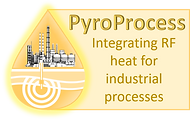PyroPole
Rapid, efficient and even heating of atmospheric and subterranean volumes
PyroPole technology utilizes electrode(s) to transfer dielectric RF energy to surrounding domains such as subterranean formation or atmospheric air. Unlike the PyroHeater, which relies on standard conductive/convective heat transfer, akin to a kitchen stovetop, PyroPole acts like a microwave oven, rapidly, evenly & efficiently heating large volumetric domains. However the Ghz waves from a microwave oven would bounce off the rock and soil, generating little penetrative heat. Therefore, lower radio frequencies are used to achieve deeper energy penetration to further heat propagation deep into surrounding domains.

The multi PyroPole approach utilizes a matrix of closely spaced boreholes with individual positive or negative copper/aluminum electrodes inside them. The inner PyroPole electrodes act as the exciters (positive poles) with the outer PyroPoles acting as the guard rows (negative poles), completing the circuit while keeping the energy from going off in random directions and heating outside the targeted volume. As the RF energy flows from positive PyroPoles through lossy mediums towards the negative PyroPoles, the dielectric resistance generates heat as the polar molecules are excited by the RF waves flowing through them.

The single PyroPole utilizes a dipole electrode to propagate RF energy in two lobes around a middle choke point, heating subterranean volumes from individual wellbores. While less area efficient than the multi PyroPole method, the single PyroPole approach allows for conductive materials to transmit energy and concentrate it at targeted domains. This along with fewer wellbores to be drilled, makes it ideal for extracting resources from relatively deep reservoirs




